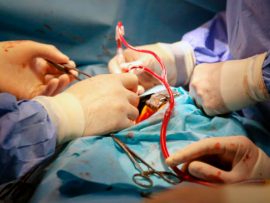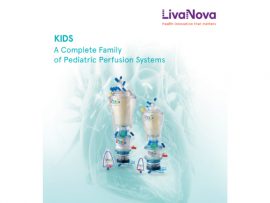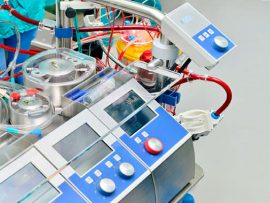Abstract Andexanet alfa is an analog of activated factor X and is used as an antagonist of anti-activated factor X agents. Andexanet alfa is useful for hemostasis in emergent bleeding..
WeiterlesenAbstract Extracorporeal membrane oxygenation (ECMO) supplies circulatory support and gas exchange to critically ill patients. Despite the use of systemic anticoagulation, blood exposure to ECMO surfaces causes thromboembolism complications. Inhibition..
WeiterlesenAbstract Antithrombin (AT) is a natural anticoagulant pivotal in inactivating serine protease enzymes in the coagulation cascade, making it a potent inhibitor of blood clot formation. AT also possesses anti-inflammatory..
WeiterlesenAbstract Background Children with end-stage lung disease are commonly managed with extracorporeal life support (ECLS) as a bridge to lung transplantation. A pumpless artificial lung (MLung) is a portable alternative..
WeiterlesenAbstract Objectives Anemia and transfusion are common in cardiac surgery patients, and are associated with significant morbidity and mortality. Multiple perioperative interventions have been described to reduce blood transfusion, but..
WeiterlesenAbstract Background Heparin rebound is a common observed phenomenon after cardiac surgery with CPB and is associated with increased postoperative blood loss. However, the administration of extra protamine may lead..
WeiterlesenAbstract Objective To identify and compare the rates of cannula-associated (CaDVT) on venovenous (VV-ECMO) who receive systemic (AC) and those who do not receive AC. Design Retrospective observational study. Setting Tertiary academic medical center...
WeiterlesenAbstract Objectives We aimed to evaluate thrombotic and hemorrhagic complications with heparin versus bivalirudin use in veno-venous extracorporeal membrane oxygenation (V-V ECMO). Methods We performed a retrospective cohort study of..
WeiterlesenAbstract Background Hypersensitivity reactions to heparin are uncommon conditions but pose a serious clinical problem for patients requiring cardiopulmonary bypass. Bivalirudin is a reversible direct thrombin inhibitor that can be..
WeiterlesenAbstract Unfractionated heparin (UFH) is the most used anticoagulant in patients receiving veno-venous extracorporeal membrane oxygenation (VV-ECMO). Its therapeutic levels are monitored using activated partial thromboplastin time ratio (aPTTr) or..
WeiterlesenAbstract Protamine, a highly basic protein isolated from salmon sperm, is the only clinically available agent to reverse the anticoagulation of unfractionated heparin. Following intravenous administration, protamine binds to heparin..
WeiterlesenAbstract The contact between the blood and the surface of medical materials causes a series of rejection reactions. In this process, the plasma protein is adsorbed to the surface of..
WeiterlesenAbstract Introduction There are several types of surface treatments (coatings) aimed at improving the biocompatibility of cardiopulmonary bypass (CPB) circuit. Some coatings appear to require higher doses of heparin to..
WeiterlesenAbstract This study described the outcomes of patients receiving topical, nebulized, endobronchial, or systemic tranexamic acid (TXA) for bleeding events while on extracorporeal membrane oxygenation (ECMO). We performed a single-center..
WeiterlesenAbstract We have read with interest the work by Helms et al., a single-center study with 30 patients (16 on veno-venous and 14 on veno-arterial extracorporeal membrane oxy-genation (ECMO)), with..
WeiterlesenAbstract Rationale: Definitive guidelines for anticoagulation management during veno-venous extracorporeal membrane oxygenation (VV ECMO) are lacking, while bleeding complications continue to pose major challenges. Objectives: To describe anticoagulation modalities and..
WeiterlesenAbstract Hemostatic disturbances after cardiac surgery can lead to excessive postoperative bleeding. Thromboelastography (TEG) was employed to evaluate perioperative coagulative alterations in patients undergoing cardiac surgery with cardiopulmonary bypass (CPB),..
WeiterlesenAbstract The aim of cardiopulmonary bypass is the maintenance of a sufficient whole body perfusion and gas exchange during open or closed heart surgery procedure (coronary artery bypass grafting, valve..
WeiterlesenAbstract Heparin-induced thrombocytopenia (HIT) is an immune-mediated from unfractionated or low-molecular-weight heparin that results in thrombocytopenia and potentially catastrophic thrombosis. HIT occurs due to the development of platelet-activating antibodies against multimolecular..
WeiterlesenAbstract During extracorporeal membrane oxygenation (ECMO) blood is exposed to artificial surfaces, resulting in contact activation of the intrinsic coagulation pathway initiated by coagulation factor XII (FXII). Little is known..
WeiterlesenAbstract Background: Hospitalized COVID-19 patients with hypoxemic respiratory failure may deteriorate despite invasive mechanical ventilation and thus require extracorporeal membrane oxygenation (ECMO) support. Unfractionated heparin (UFH) is the antithrombotic of..
WeiterlesenAbstract Background: Systemic anticoagulation with heparin during cardiopulmonary bypass (CPB) should be neutralized by protamine administration to restore normal hemostasis. Our previous study showed the protamine-to-heparin ratio (P-to-H) of 1:1..
WeiterlesenAbstract Background: Infants < 10 kg undergoing cardiac surgery with cardiopulmonary bypass (CPB) may receive either fresh frozen plasma (FFP) or other solutions in the CPB priming volume. The existing..
WeiterlesenAbstract Artificial lung membranes as the core module of the extracorporeal membrane oxygenation technology (ECMO) execute the function of extracorporeal blood-gas barrier accomplishing CO2/O2 exchange with blood. However, the unsatisfactory hemocompatibility..
WeiterlesenAbstract Vascular endothelial damage may activate hypercoagulation and contribute to the development of acute kidney injury (AKI). This study aimed to investigate whether early alteration in coagulation was associated with..
WeiterlesenAbstract Introduction: The aim of this study was to determine the effect of fresh frozen plasma (FFP) for priming of cardiopulmonary bypass (CPB) circuit on rotational thromboelastometry (ROTEM) and transfusion in..
WeiterlesenAbstract This literature review examines perfusion safety in cardiothoracic surgery, with a primary focus on cardiopulmonary bypass (CPB) and circulatory devices. PRISMA guidelines were followed and various databases, including PubMed,..
WeiterlesenAbstract Background (FXII) is a multifunctional capable of activating thrombotic and inflammatory pathways. FXII has been linked to thrombosis in (ECMO), but the role of FXII in ECMO-induced inflammatory complications has not..
WeiterlesenAbstract Background Cardiopulmonary bypass (CPB) causes coagulation disorders after surgery. This study aimed to compare the coagulation parameters after congenital cardiac surgery with miniaturised CPB (MCPB) versus conventional CPB (CCPB)...
WeiterlesenAbstract Introduction Perioperative coagulopathy is common in patients undergoing aortic surgery, increasing the risk of excessive blood loss and subsequent allogeneic transfusion. Blood conservation has become a vital part of cardiovascular..
Weiterlesen









